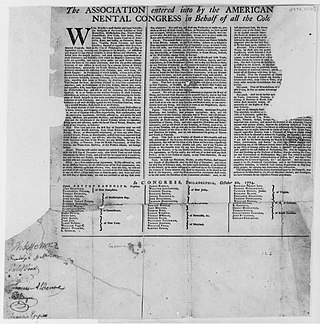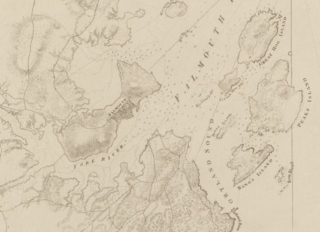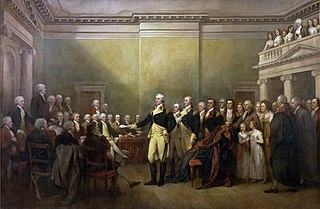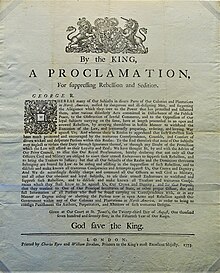
The American Revolutionary War, also known as the Revolutionary War or American War of Independence, was the military conflict of the American Revolution. American Patriot forces, organized as the Continental Army and commanded by George Washington, defeated the British, leading to the Treaty of Paris in 1783, in which Great Britain recognized the independence and sovereignty of the United States. In the war, American Patriot forces eventually gained the support of France and Spain. The British and Loyalist forces also included Hessian soldiers from Germany. The conflict was fought in North America, the Caribbean, and the Atlantic Ocean.

The American Revolution was an ideological and political revolution based on the principles of the American Enlightenment in which the Second Continental Congress, representing the Thirteen Colonies, convened in what is now Independence Hall in Philadelphia, ultimately declaring their total independence from the British Empire, authorizing the creation of the Continental Army, and electing George Washington as its commander in the ensuing American Revolutionary War.

The Declaration of Independence, formally titled The unanimous Declaration of the thirteen united States of America, is the founding document of the United States. On July 4, 1776, it was adopted unanimously by the 56 delegates to the Second Continental Congress, who had convened at the Pennsylvania State House, later renamed Independence Hall, in the colonial era capital of Philadelphia. The declaration explains to the world why the Thirteen Colonies regarded themselves as independent sovereign states no longer subject to British colonial rule.

The Thirteen Colonies were a group of British colonies on the Atlantic coast of North America during the 17th and 18th centuries. Grievances against the imperial government led the 13 colonies to begin uniting in 1774 and expelling British officials by 1775. Assembled at the Second Continental Congress in Philadelphia, they appointed George Washington as commander-in-chief of the Continental Army to fight the American Revolutionary War. In 1776, Congress adopted the Declaration of Independence as the United States of America. Defeating invading British armies with French help, the Thirteen Colonies gained sovereignty with the Treaty of Paris in 1783.

The Continental Congress was a series of legislative bodies, with some executive function, for the thirteen colonies of Great Britain in North America, and the newly declared United States before, during, and after the American Revolutionary War. The Continental Congress refers to both the First and Second Congresses of 1774–1781 and at the time, also described the Congress of the Confederation of 1781–1789. The Confederation Congress operated as the first federal government until being replaced following ratification of the U.S. Constitution. Until 1785, the Congress met predominantly at what is today Independence Hall in Philadelphia, though it was relocated temporarily on several occasions during the Revolutionary War and the fall of Philadelphia.

George III was King of Great Britain and Ireland from 25 October 1760 until his death in 1820. The Acts of Union 1800 unified Great Britain and Ireland into the United Kingdom of Great Britain and Ireland, with George as its king. He was concurrently Duke and Prince-elector of Hanover in the Holy Roman Empire before becoming King of Hanover on 12 October 1814. He was a monarch of the House of Hanover, who, unlike his two predecessors, was born in Great Britain, spoke English as his first language, and never visited Hanover.

The Quebec Act, 1774 was an Act of the Parliament of Great Britain which set procedures of governance in the Province of Quebec. One of the principal components of the Act was the expansion of the province's territory to take over part of the Indian Reserve, including much of what is now southern Ontario, Illinois, Indiana, Michigan, Ohio, Wisconsin, and parts of Minnesota.

Timeline of the American Revolution—timeline of the political upheaval culminating in the 18th century in which Thirteen Colonies in North America joined together for independence from the British Empire, and after victory in the Revolutionary War combined to form the United States of America. The American Revolution includes political, social, and military aspects. The revolutionary era is generally considered to have begun with the passage of the Stamp Act in 1765 and ended with the ratification of the United States Bill of Rights in 1791. The military phase of the revolution, the American Revolutionary War, lasted from 1775 to 1783.

The Olive Branch Petition was adopted by the Second Continental Congress on July 5, 1775, and signed on July 8 in a final attempt to avoid war between Great Britain and the Thirteen Colonies in America. The Congress had already authorized the invasion of Canada more than a week earlier, but the petition affirmed American loyalty to Great Britain and entreated King George III to prevent further conflict. It was followed by the July 6 Declaration of the Causes and Necessity of Taking Up Arms, however, which made its success unlikely in London. In August 1775, the colonies were formally declared to be in rebellion by the Proclamation of Rebellion, and the petition was rejected by the British government; King George had refused to read it before declaring the colonists traitors.

The Second Continental Congress was the late-18th-century meeting of delegates from the Thirteen Colonies that united in support of the American Revolution and its associated Revolutionary War, which established American independence from the British Empire. The Congress created a new country that it first named the United Colonies, and in 1776, renamed the United States of America. The Congress began convening in Philadelphia, on May 10, 1775, with representatives from 12 of the 13 colonies, after the Battles of Lexington and Concord.

The Continental Association, also known as the Articles of Association or simply the Association, was an agreement among the American colonies adopted by the First Continental Congress in Philadelphia on October 20, 1774. It was a result of the escalating American Revolution and called for a trade boycott against British merchants by the colonies. Congress hoped that placing economic sanctions on British imports and exports would pressure Parliament into addressing the colonies' grievances, especially repealing the Intolerable Acts, which were strongly opposed by the colonies.

The Restraining Acts of early 1775 were two Acts passed by the Parliament of Great Britain, which limited colonial trade in response to both increasing and spreading civil disobedience in Massachusetts and New England, and similar trade restrictions instituted by elected colonial representatives. With time the foment would spread to most of its American Colonies. The first restraining act, known variously as the New England Trade And Fisheries Act, the New England Restraining Act, or the Trade Act 1775, limited the export and import of any goods to and from only Great Britain, Ireland, and the British West Indies; it also prohibited the New England colonies from fishing in the waters off Newfoundland and most of America's Atlantic coast, without special permissions and documentation, and imposed stiff penalties on both perpetrators and administrators if violations occurred. Previously legal or finessed trade between the colonies themselves or with other nations was prohibited, and enforced by naval blockade, effective July 1, 1775. The second restraining act, known also as the Trade Act 1775, similarly limited the export or import of any goods by way of only Great Britain, Ireland, and the British West Indies for most colonies south of New England; it was passed shortly after the first, upon receiving news in April that the colony's trade boycott had spread widely among other colonies. New York, Delaware, North Carolina and Georgia would escape these restraints on trade, but only for a few months.

The Model Treaty, or the Plan of 1776, was a template for commercial treaties that the United States planned to make with foreign powers during the American Revolution against Great Britain. It was drafted by the Continental Congress to secure economic resources for the war effort, and to serve as an idealistic guide for future relations and treaties between the new American government and other nations. The Model Treaty thus marked the revolution's turning point towards seeking independence, and is subsequently considered a milestone in U.S. foreign relations.

The Prohibitory Act was British legislation in late 1775 that cut off all trade between the Thirteen Colonies and England and removed the colonies from the King's protection. In essence, it was a declaration of economic warfare by Britain as punishment to the American colonies for the rebellion against the King and British rule that became known as the American Revolutionary War.
The Provincial Congresses were extra-legal legislative bodies established in ten of the Thirteen Colonies early in the American Revolution. Some were referred to as congresses while others used different terms for a similar type body. These bodies were generally renamed or replaced with other bodies when the provinces declared themselves states.

The Burning of Falmouth was an attack by a fleet of Royal Navy vessels on the town of Falmouth, Massachusetts. The fleet was commanded by Captain Henry Mowat. The attack began with a naval bombardment which included incendiary shot, followed by a landing party meant to complete the town's destruction. The attack was the only major event in what was supposed to be a campaign of retaliation against ports that supported Patriot activities in the early stages of the American Revolutionary War.

The Petition to the King was a petition sent to King George III by the First Continental Congress in 1774, calling for the repeal of the Intolerable Acts. The King's rejection of the Petition, was one of the causes of the later United States Declaration of Independence and American Revolutionary War. The Continental Congress had hoped to resolve conflict without a war.
Diplomacy in the Revolutionary War had an important impact on the Revolution, as the United States evolved an independent foreign policy.

Then Province of Maryland had been a British / English colony since 1632, when Sir George Calvert, first Baron of Baltimore and Lord Baltimore (1579-1632), received a charter and grant from King Charles I of England and first created a haven for English Roman Catholics in the New World, with his son, Cecilius Calvert (1605-1675), the second Lord Baltimore equipping and sending over the first colonists to the Chesapeake Bay region in March 1634. The first signs of rebellion against the mother country occurred in 1765, when the tax collector Zachariah Hood was injured while landing at the second provincial capital of Annapolis docks, arguably the first violent resistance to British taxation in the colonies. After a decade of bitter argument and internal discord, Maryland declared itself a sovereign state in 1776. The province was one of the Thirteen Colonies of British America to declare independence from Great Britain and joined the others in signing a collective Declaration of Independence that summer in the Second Continental Congress in nearby Philadelphia. Samuel Chase, William Paca, Thomas Stone, and Charles Carroll of Carrollton signed on Maryland's behalf.

The 27 grievances is a section from the United States Declaration of Independence. The Second Continental Congress's Committee of Five drafted the document listing their grievances with the actions and decisions of King George III with regard to the Colonies in North America. The Second Continental Congress voted unanimously to adopt and issue the Declaration of Independence on July 4, 1776.














